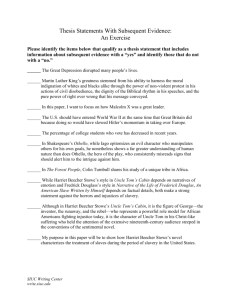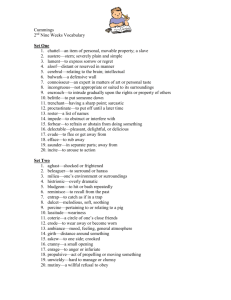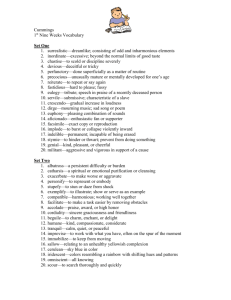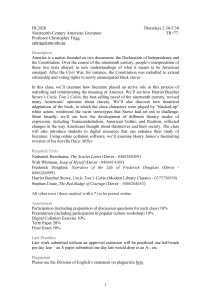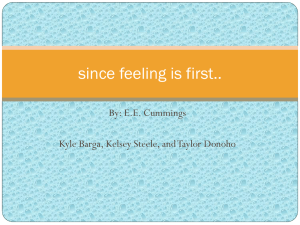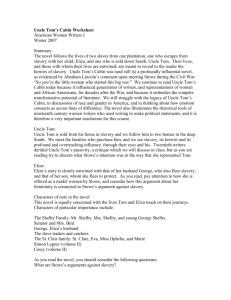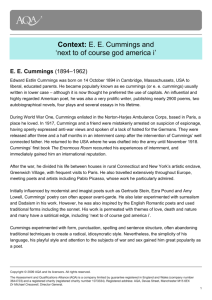Choreographing History: Uncle Tom as Modernist Ballet
advertisement
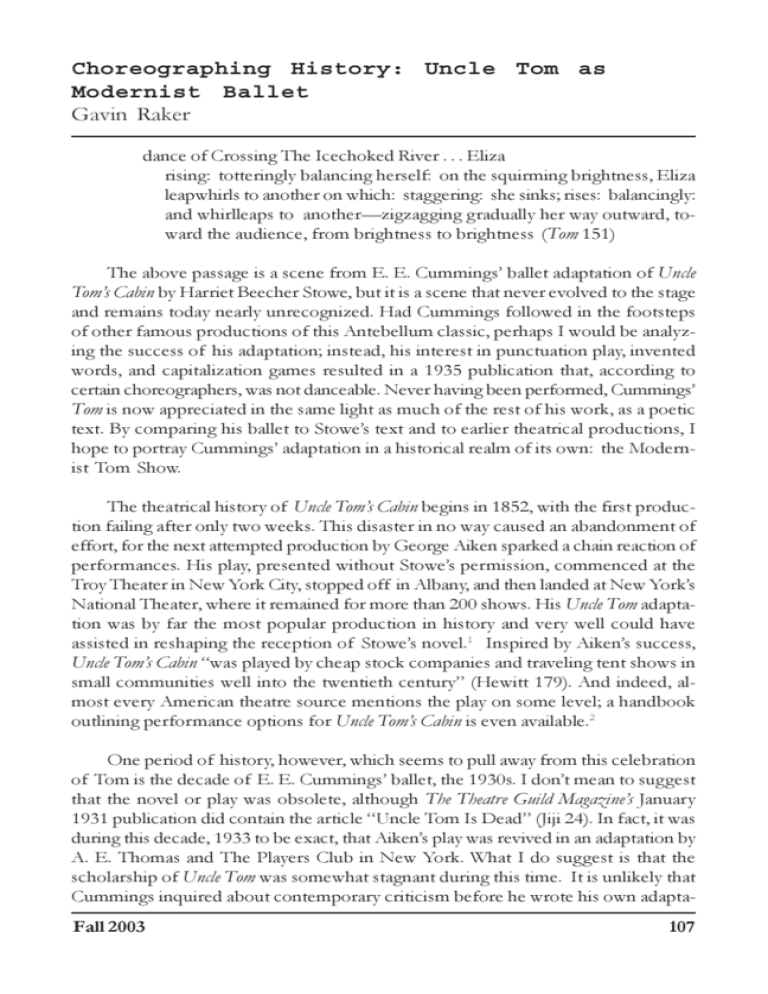
Choreographing History: Uncle Tom as Modernist Ballet Gavin Raker dance of Crossing The Icechoked River . . . Eliza rising: totteringly balancing herself: on the squirming brightness, Eliza leapwhirls to another on which: staggering: she sinks; rises: balancingly: and whirlleaps to another—zigzagging gradually her way outward, toward the audience, from brightness to brightness (Tom 151) The above passage is a scene from E. E. Cummings’ ballet adaptation of Uncle Tom’s Cabin by Harriet Beecher Stowe, but it is a scene that never evolved to the stage and remains today nearly unrecognized. Had Cummings followed in the footsteps of other famous productions of this Antebellum classic, perhaps I would be analyzing the success of his adaptation; instead, his interest in punctuation play, invented words, and capitalization games resulted in a 1935 publication that, according to certain choreographers, was not danceable. Never having been performed, Cummings’ Tom is now appreciated in the same light as much of the rest of his work, as a poetic text. By comparing his ballet to Stowe’s text and to earlier theatrical productions, I hope to portray Cummings’ adaptation in a historical realm of its own: the Modernist Tom Show. The theatrical history of Uncle Tom’s Cabin begins in 1852, with the first production failing after only two weeks. This disaster in no way caused an abandonment of effort, for the next attempted production by George Aiken sparked a chain reaction of performances. His play, presented without Stowe’s permission, commenced at the Troy Theater in New York City, stopped off in Albany, and then landed at New York’s National Theater, where it remained for more than 200 shows. His Uncle Tom adaptation was by far the most popular production in history and very well could have assisted in reshaping the reception of Stowe’s novel.1 Inspired by Aiken’s success, Uncle Tom’s Cabin “was played by cheap stock companies and traveling tent shows in small communities well into the twentieth century” (Hewitt 179). And indeed, almost every American theatre source mentions the play on some level; a handbook outlining performance options for Uncle Tom’s Cabin is even available.2 One period of history, however, which seems to pull away from this celebration of Tom is the decade of E. E. Cummings’ ballet, the 1930s. I don’t mean to suggest that the novel or play was obsolete, although The Theatre Guild Magazine’s January 1931 publication did contain the article “Uncle Tom Is Dead” (Jiji 24). In fact, it was during this decade, 1933 to be exact, that Aiken’s play was revived in an adaptation by A. E. Thomas and The Players Club in New York. What I do suggest is that the scholarship of Uncle Tom was somewhat stagnant during this time. It is unlikely that Cummings inquired about contemporary criticism before he wrote his own adaptaFall 2003 107 tion, but if he had, he would have found it to be sparse, if not scattered. According to Harriet Beecher Stowe: A Reference Guide (1977), there were absolutely no books published about the author or the work in question during this decade. However, the minor criticisms that do exist could possibly have been influenced by Thomas’ revived production. Furthermore, Cummings, although he twisted his adaptation into a modernist display, was also likely influenced by Aiken and / or Thomas for his melodramatic scenes and typified characters. Although Thomas opens Act One with George mourning his position as a slave, and Cummings opens Episode One with Tom’s “Dance of Religious Ecstacy,” the first dominating scene in both texts is Eliza crossing the Ohio River. Because the dramas call such attention to this character and portray her as a delicate but independent woman prancing across white plastic cubes, actual blocks of ice, or sparkles of light, I contend that she melts down from a semi-complex Eliza in Stowe’s novel to a mere icon in subsequent texts. At the moment of escape in the novel, Eliza is not simply an image, but a character experiencing psychological calamity: “A thousand lives seemed to be concentrated in that one moment to Eliza. . . . It was a desperate leap—impossible to anything but madness and despair” (Stowe 52). In Thomas’ version, both internal and concrete dialogue are missing as Eliza escapes in Act One, Scene Five. We are only given italic stage directions: “ELIZA appears with HARRY on a cake of ice and floats slowly across the scene. Hounds chase after her” (15). And when we arrive at the Modernist Eliza, she is a tottering phantom “balancing herself: on the squirming brightness,” being chased, not by actual hounds, as many productions incorrectly include, but by blatantly iconographic “luminous dogfaces” (Cummings 151). Of course, we must remember that the degree to which stage directions are interpreted and performed is in the hands of directors and actors, and that a psychological journey could, in fact, be portrayed, but I think it is worth noting that in Thomas’ text, where Eliza is a speaking character, she has no voice in this scene. And then in Cummings’ version, she has mutated into a silent phantom, without even a body. The psychological journey of Eliza’s character does seem to diminish between novel and play, which is problematic considering that critics and readers cannot easily nullify the visual Eliza they have come to know from the stage. The somewhat limited scholarship of the 1930s, the decade of Cummings’ adaptation, reflects this emblematic perception of Eliza’s character as well as other characters in the novel. The authors of Harriet Beecher Stowe, Economic Criticism in American Fiction, and The Negro in American Fiction all classify Stowe’s characters as icons, each representing a specific ideal. They also, whether directly or indirectly, criticize Stowe for creating stereotypes. Claude Flory writes, “[Uncle Tom’s Cabin’s] importance as a human and historical document considerably surpasses its significance as literary art. The characters are essentially types rather than individuals” (207). The most comprehensive assessment of these types appears in The Negro in American Fiction: 108 Spring Eliza and George, if not models of Christian forgivingness, are still virtue in distress, to be saved by poetic justice. Eva’s ethereal goodness, and Legree’s cruelty are examples among the white characters of the same idealization. But Topsy must not be overlooked; although minstrel shows have made her into a Puck in blackface, Mrs. Stowe intended to show her as a pathetic victim of slave-trading as well. (Brown 36-7) One must question whether the “types” would be so obvious without the dominating stage productions offering their most basic versions of Evas, Elizas, and Toms.3 How does Uncle Tom’s Cabin transform from bestseller to theatrical phenomenon to literary non-masterpiece? And have our perceptions of certain characters and themes been perverted as a result of the transformation that takes place somewhere between the page and the stage? Contrary to what one might expect, in its obscurity, Cummings’ Modernist take on Eliza is somewhat connected to Stowe’s version of the character. She writes, “With wild cries and desperate energy she leaped to another and still another cake; —stumbling —leaping —slipping —springing upwards again!” (52). Comparing Stowe’s unconventional syntax to Cummings’ passage, one is struck by the fact that textually they look strikingly similar, with punctuation interruption, gerunds, and ascending / descending motions. Cummings describes Eliza’s movement as “her crude whirlleaping-reelsinking-staggerrising-leapwhirling progress” (151). The only difference is marked by the change from real gerunds in Stowe’s version to invented ones in Cummings’ version, but these inventions seem visually appropriate for a ballet production, and are extremely directive. “Reelsinking” offers a much more vivid, if not exegetic, impression than does “slipping.” Because Cummings’ textual ballet never actually came to life, I can really only imagine how his words might work on stage, but I like to believe that it could be choreographed in such a way that the audience would understand the complexity behind certain characters and scenes. If that were the case, Eliza’s melodramatic motions might not detract from intense, complicated characterization because the audience could do a close reading of physical, rather than verbal, dialogue. The audience would internalize each motion and open the door to a wide range of interpretations. Therefore, the complexity of a character depends somewhat on her presence but more so on how the viewers decode that presence. Despite how Cummings’ text brazenly portrays Eliza as the “virtue in distress” icon, wouldn’t viewers manipulate the image of her into their own character, whether complex or condensed? The definitive interpretation of a character depends largely on what kinds of emotions he/she evokes in the spectators. I believe Cummings was striving to provide intense visual sensations paralleling Stowe’s verbal / emotional attributes, which would lead to multi-leveled characters, but because his style was so peculiarly modern, the ballet’s choreographer could not visualize anything beyond the page. Fall 2003 109 Every aspect of Cummings’ ballet could be considered avant-garde, but Eva’s death scene seems to breach tradition most effectively. M. H. Abrams, in his concise Glossary of Literary Terms, uses words like “expressionism,” “surrealism,” and “dislocation of parts” to describe Modernism (119), and Cummings’ adaptation of this powerful scene fits this mold exceptionally well. There is nothing realistic about Eva floating above the stage, surrounded by winged “childangels” (158). Cummings writes: Pirouettingly the [childangels], each led by a spirit hovering on shining wings who holds before her a single shining wing, advance toward oneanother. Touching, the beams fuse, the angelleaders meet. Silently the single radiance, gathering itself, goes inward as, inturning, the leaders float toward Eva: followed by pirouetting pair after pair of quivering spirits (158) This passage is primarily expressionistic because we do not witness any real moment of death with eyes closing or cessation of breath as we do in Stowe’s novel: “The child lay panting on her pillows, as one exhausted,—the large clear eyes rolled up and fixed” (257). Instead, Eva glides through a spiritual haze, creating a “tensely emotional vision” (Abrams 62) for all who witness her transcendence. Cummings’ portrayal of such a fantastical Eva also epitomizes surrealism in that it depicts “the material of dreams, of states of mind between sleep and waking, and of natural or artificially induced hallucinations” (Abrams 205). The dislocation of parts is perhaps the most difficult Modernist technique to pin down in this passage, but it does exist. We are forced to make a connection, however confusing, between the roles of Eva, “childangels,” “angelleaders,” “quivering spirits,” and fusing light beams. There is no obvious explanation for these different types of angelic representations but rather a number of possibilities. Perhaps Eva’s status is somewhere beneath the childangels, who are somewhere beneath the angelleaders, and perhaps the fusing light beams represent God. The revelation is not in knowing, but in contemplating the possibilities and experiencing new emotions. For Stowe and for a traditional Uncle Tom performance such as Thomas’, the meaning of this scene is clear: Eva is the manifestation of “ethereal goodness” (Brown 36). At the moment of death she says, “I see...I see...the crystal gates, wide—wide open—Love— joy—peace—(Her head falls to one side, her eyes close)” (Thomas 36). The expressionistic and surreal properties of Modernism in Cummings’ work are bold enough to stand on their own, but Cummings includes another element to enhance abstraction. He applies vivid images to a geometric stage and creates (for reader or viewer) what is comparable to a Cubist painting. A realistic setting does not allow for the kind of interpretive freedom that exists in Cummings’ creation. He transforms the stage from what might be an elaborate cabin into a geometric shape to 110 Spring evoke a more thought-provoking appearance. In the opening scene of Episode One, dancers form a “praying pyramidal silence” on “a soft grey cube” in “halflight” (Cummings 147). The image he creates is designed to draw our eyes from a broad foundation to a peak reaching into the hazy heavens. With this scene in place, Eliza enters the stage and “holds before her a brown doll,” which represents her daughter through the final episode of the ballet, where Cassy recognizes Eliza in the doll’s face. These, and other indicative images (“glowingly enormous cigar” [149], “golden doors” [170], “Human Bloodhounds” [150]), are not invented by Cummings. He extracts some of the most minuscule elements from Stowe’s novel and metamorphoses them until they become larger than life unrealities. Stowe does mention that Haley “resumed his cigar . . . and began his smoking again” (111), and that he chased Eliza “like a hound after a deer” (52), but for Cummings symbols are more substantive. One might argue that Cummings’ images are meant to be iconographic and fall into the pattern of cliché which evolved from one production to the next. In her article, “Uncle Tom’s Cabin as a Realist Novel,” Robyn Warhol writes: To be sure, all writing is ‘conventional’: for a literary text to make any sense within its context, it must either adopt certain generic habits and patterns or reject them, but in either case, it will make its meaning in relation to those conventions. To damn a text for conventionality, then, would be to charge its author with using conventions that have become clichés, without renewing them through some redeeming spark of originality. (287) For the sake of Tom, the question remains: did Cummings successfully redeem the clichés which migrated from George Aiken’s 1852 production to A. E. Thomas’ 1933 revival? Considering that Thomas mimics Aiken’s performance and unloads real hounds to chase after Eliza, I would say that Cummings is much more inventive and does create a “spark of originality” with his human bloodhounds. In Thomas’ Act One, Scene Four, Eliza says, “My child, we will be free—or perish!” Then: “Two men enter with hounds on a leash. . . . Hounds chase after her. HALEY, LOKER and MARKS follow across after the hounds” (Thomas 14-15). Cummings’ rendering at least speaks more effectively about the bestiality, not to mention absurdity, of humans chasing humans for the sake of enslavement, an idea not foreign to Stowe’s novel. Furthermore, the freshness of Cummings’ idea entices his audience to investigate numerous meanings for such an image. What do we make of an enigma that falls somewhere between hound and human? In the same instance that he rejects “certain generic habits and patterns,” he also adopts them. Perhaps Cummings felt free to experiment with syntax and other Modernist techniques, and was not originally concerned with stage presence, because Tom was not actually his idea. Interestingly, there is conflicting information regarding who first conceptualized the ballet. In the 1930s Cummings was living in New York City and Fall 2003 111 was acquainted with Lincoln Kirstein and George Balanchine, whose School of American Ballet evolved into the acclaimed New York City Ballet. Kirstein claims in his memoirs that he commissioned Cummings to “write a libretto for a choreodrama based on Uncle Tom’s Cabin” (42), but Cummings’ biographer, Richard S. Kennedy, tells a different story. He says that Kirstein did, indeed, want Cummings to write a ballet, but that it was not Kirstein’s idea to adapt Stowe’s novel: Estlin, attracted by the idea [of a ballet scenario], talked it over with Marion, who suggested an adaptation of Uncle Tom’s Cabin, perhaps because she knew that a dramatic version of the book had proved to be one of the most popular presentations of the nineteenth-century American theater. (Kennedy 344) No matter who instigated the affair, both parties were interested in the success it could bring, and encouraged its production. It was Balanchine, the choreographer, who could not get beyond the modernist idiosyncrasies of Cummings’ work. Kirstein says, When I read Balanchine what Estlin had written, translated into demotic French, he said it might well be splendid prose or even poetry, but there were no pretexts therein for dancing. . . . How could I ever explain to so eminent an author that what he had written at our command was, for us, quite useless? (42-3) This very quote demonstrates the nature of the confusion evoked by Cummings’ style: Balanchine could not even classify the ballet on a literary scale. Is it “splendid prose,” or is it “even poetry?” I’m not sure whether it was because Balanchine “was interested only in pianos, automobiles, and girls,” or whether it was because he “fitted patterns from his analysis of the music onto a formal sequence largely governed by accident” (Kirstein 40, 38), but he was not able to recognize Cummings’ ballet for what it truly was. Perhaps only Cummings’ followers or Uncle Tom fanatics are able to notice the “spark of originality” in his revamped clichés. There was one positive identifiable element in Tom that persuaded David Diamond, a New York composer, to approach Cummings regarding a libretto after his numerous attempts to find a musician. Diamond acknowledged that the adaptation was “a real ballet script . . . perfectly proportioned in good theatrical variations” (quoted in Kennedy 372). Moreover, to Richard S. Kennedy, Cummings’ script is 112 a genuine modern ballet in two important respects. First of all, the principal actions, relationships, attitudes, and ideas are expressed by means of dance. . . . But more than this, Cummings perceived in Stowe’s story the elements of Christian epic that gave her work its continued interest over the decades. (Kennedy 373) Spring Apparently Kennedy thinks, and I agree, that Cummings bridged the gap between dance and literature, production and text. I would go a step further, however, to add that not only did Cummings express ideas “by means of dance,” but he designed icons that would extend reality and crafted a Modernist painting within the ballet to inspire meaningful, intellectual interpretation. I do not deny Cummings’ Modernist obstacles of disjointed syntax and textual peculiarity, but I believe in the possibility of performance. Regarding Cummings’ perception of “Christian epic” in Uncle Tom’s Cabin, I somewhat disagree with Kennedy. Cummings did emphasize aspects of Christianity, but I believe he did so primarily to enhance the ballet’s supernatural potential. Expectedly, he saves the most magical scene for the last moment of the ballet: Tom’s death and ultimate transcendence. Cummings writes: Appear two mighty golden doors upon which blazes LIGHT outward goldenly slowly the huge doors open—revealing an immeasurable radiance and which, prodigiously forthpouring upon a stage drowned in glory, becomes angels in white robes with harps of gold and crowns C U R T A I N (170) What Cummings omits from Stowe’s text, as evident in the above passage, are actual replicas of Christianity; instead, he simulates spirituality through more indirect references to religion. Stowe’s description of Tom’s death blatantly leads the audience to a Christian reading. In her novel Tom says, “‘I’m right in the door, going into glory! O, Mas’r George! Heaven has come! I’ve got the victory!— the Lord Jesus has given it to me! Glory be to His name!’” (Stowe 362). Cummings’ version, again pulling a smaller image (the door) into a magnificent image (golden “huge doors”), sways from direct Christian labeling. In this passage, as well as throughout the ballet, he rarely, if ever, uses words like Bible, God, Jesus, or cross. Instead, Tom carries a “babebook,” and yearns for “radiance” (147, 170). In fact, the only direct mention of Christianity occurs in a negative context. After Tom suffers through a Legree beating, Cummings writes, “suddenly over blue distance falls a Christian Hell” (166). He even adds unusually realistic elements to the scene, such as “the goddessmonster of all Africa” and a “red fiend” (166). I cannot completely refute Kennedy’s opinion, however, because Cummings does include some Christian-like dance titles; there is the “dance of Heavenly Longing . . . Eva” and “dance of Revelation Through The Eternal Word . . . Tom” (157, 158). I simply believe that Cummings’ adaptation is “a Fall 2003 113 genuinely modern ballet” because he follows a Modernist design, and profits from expressionism, surrealism, imagism, and distortion, rather than from elements of “Christian epic.” Cummings’ ballet was, indeed, modern on a conceptual level, but because it never produced and performed on stage, one must consider what takes place between the lines of text. Why did Cummings search for a producer to no avail, and why was it so difficult to find a musician who would set his words to music? In A History of Modern Poetry, David Perkins explains that in the majority of his poetry Cummings was concerned with the look of the poem on the page. Manipulating letters, syllables, punctuation, capitals, columns of print, indentation, line length, and white space as visual or spatial forms, Cummings arranged them in order to enact feeling and carry meaning. (42) Cummings was so consumed by textual appearance that perhaps he did not consider making the proper adjustments from poetry to production. Tom is replete with even his most unusual grammatical manipulations, including extensive use of colons and semicolons, parenthesis play, and the creation of images through word layout. In the “dance of Revelation Through The Eternal Word,” which occurs just before Eva’s death, Cummings mingles elegiac words with numerous colons to create a sensation which may not exist if we saw only the words (without textual manipulation). The following passage is taken from a longer section, all of which contains this punctuation pattern: [Tom] fallkneels, kisses the book: upgushing, soars through manycoloured air with highwaving arms: drops, bowed, book held at arms’ length: hurtling toward outswimming Eva he plunges; wallowing, kisses the book; writhekneels: squirmstands— (158) The punctuation proves important because the last line of this passage depicts Tom “plucking all the sky into all the world” (158); the repeated colons symbolize, and actually resemble plucking. This scene is, of course, one of the most powerful moments of Uncle Tom’s Cabin, and I can understand the difficulty in translating the power of the text to the stage. Without the punctuation to enhance the meaning, and without the wonderfully poetic closing line, what is left but Tom and his Bible “upgushing” and “wallowing?” Motion is present, but meaning is lost. The same problem (loss of meaning between page and production) might occur in a number of instances where the layout of the text depicts advancement. A line will begin on the left of the page, but each subsequent line moves farther and farther to the right. With this technique, Cummings seems to suggest that progression, or 114 Spring forward motion, is both physical and cerebral because the textual changes often occur when a character experiences an epiphany. For instance when Haley, in Episode One, moves toward Tom and Eliza (physical advancement), Eliza realizes that she must escape (experiences epiphany); all the while, the text moves more and more to the right. The same kind of development occurs when Tom is on the verge of death, disappointed in God, but finding inspiration from Eva: Tom (*) stirs very gradually his open hand closes on Eva’s locket— he quivers; lifting sacredly the locket, he passes the chain over his head; and collecting—slowly—himself into himself surges, hugely upward: (160) Just as his body ascends, so does his spirit. Again, without the enhancing textual image a sense of depth is lacking. On stage this moment would be melodramatic, with Tom quivering, passing the chain over his head and surging upward, but the producers wanted something more than a melodramatic rendition; they wanted to create a performance that “would make the perfect plot for an ‘American’ ballet” (Kirstein 42). Apparently, Cummings drifted so far beyond plot into a Modernist abstraction that choreographing his ballet was deemed impossible. Whatever impeded Cummings’ ballet from performance, whether it was an uninterested choreographer or a truly untranslatable text, the fact remains that it was never danced. Like Stowe’s novel, it underwent a transformation, only reversed. Whereas Uncle Tom’s Cabin mutated from novel to dramatization, Tom began as ballet and evolved to poetry. For that reason, we have no choice but to include it with the literary history of the 1930s. Cummings’ ballet, following Stowe’s novel and Thomas’ production, is arguably melodramatic; the exaggeration of character and image offers an extreme emotional display. It also lends itself to the discussion of sentimental overcharge and clichéd iconography, but Tom deserves separate examination. It bridges generations of literary scholarship and cultures, connecting the Antebellum and Modernist periods. But more specifically, it exemplifies how one era reads another. Cummings’ interpretation is ultimately a poetic ballet poised in the corner of an empty studio, waiting for its dancers to arrive, waiting for the first, and only, performance of a Modernist Tom Show. —Lakewood, OH Fall 2003 115 Notes 1 For thorough production history of Uncle Tom’s Cabin see History of the American Theatre (1951), by Glenn Hughes, or Theatre U. S. A. (1959), by Barnard Hewitt. Both sources discuss the popularity of Aiken’s Uncle Tom’s Cabin. 2 This 1983 handbook by Vera Jiji recalls production trends and performance possibilities beginning with the play’s first showing. It also contains some contemporary theatrical commentary. More useful as a historical lens than as a modern day guide to performance. 3 In Lowance’s 1994 introduction to The Stowe Debate, he remarks that even the earliest performances of Uncle Tom’s Cabin were manipulated to spark sentimental responses from audiences. Part of the trick was to create stereotypes which “were more the focus than was any historical guilt over slavery” (3). Works Cited Abrams, M. H. A Glossary of Literary Terms. 6th ed. Fort Worth: Harcourt Brace, 1993. Ashton, Jean. Harriet Beecher Stowe: A Reference Guide. Boston: G.K. Hall, 1977. Brown, Sterling. The Negro in American Fiction. Washington, D. C.: The Associates in Negro Folk Education, 1937. Cummings, E. E. Tom. New York: Arrow Editions, 1935. Rpt. Three Plays and A Ballet. Ed. George J. Firmage. New York: October House, 1967. 141-170. Flory, Claude Reherd. Economic Criticism in American Fiction: 1792 to 1900. New York: Russell & Russell, 1937. Hewitt, Barnard. Theatre U. S. A.: 1668 to 1957. New York: McGraw-Hill, 1959. Jiji, Vera, ed. Showcasing American Drama: George Aiken / Harriet B. Stowe: Uncle Tom’s Cabin: A Handbook of Source Materials. Brooklyn: Brooklyn College, 1983. Kennedy, Richard S. Dreams in the Mirror: A Biography of E. E. Cummings. New York: Liveright, 1980. Kirstein, Lincoln. Thirty Years: Lincoln Kirstein’s The New York City Ballet. New York: Knopf, 1978. Lowance, Mason I., et al., eds. The Stowe Debate: Rhetorical Strategies in Uncle Tom’s Cabin. Amherst: U of Massachusetts P, 1994. Perkins, David. A History of Modern Poetry: Modernism and After. Cambridge: Harvard UP, 1987. Stowe, Harriet Beecher. Uncle Tom’s Cabin. Ed. Elizabeth Ammons. New York: W. W. Norton, 1994. Thomas, A. E. and George Aiken. Uncle Tom’s Cabin. Rpt. S. R. O.: The Most Successful Plays of the American Stage. Ed. Bennett Cerf and Van H. Cartmell. Garden City: Doubleday, 1944. 1-58. Warhol, Robyn. “Poetics and Persuasion: Uncle Tom’s Cabin as a Realist Novel.” Essays in Literature 13.2 (1986): 283-298. 116 Spring
